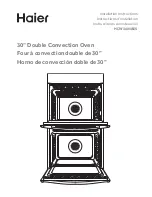
1-6
Basic Information
Microwave Measurement Procedure (USA)
A. Requirements:
1) Microwave leakage limit (Power density limit): The power density of microwave radiation emitted by a
microwave oven should not exceed 1 mW/cm2 at any point 5 cm or more from the external surface of the
oven, measured prior to acquisition by a purchaser, and thereafter (through the useful life of the oven),
5
mW/cm2 at any point 5 cm or more from the external surface of the oven.
2) Safety interlock switches: Primary interlock switch shall prevent microwave radiation emission in excess of the
requirement as above mentioned, secondary interlock switch shall prevent microwave radiation emission in
excess of 5 mW/cm2 at any point 5 cm or more from the external surface of the oven.
B. Preparation for testing:
Before beginning the actual measurement of leakage, proceed as follows:
1) Make sure that the actual instrument is operating normally as specified in its instruction booklet.
Important:
Survey instruments that comply with the requirement for instrumentation as prescribed by the performance
standard for microwave ovens, 21 CFR 1030.10(c)(3)(i), must be used for testing.
2) Place the oven tray in the oven cavity.
3) Place the load of 275±15 ml (9.8 oz) of tap water initially at 20°±5C (68°F) in the center of the oven cavity.
The water container shall be a low form of 600 ml (20 oz) beaker with an inside diameter of approx. 8.5 cm
(3-1/2 in.) and made of an electrically nonconductive material such as glass or plastic. The placing of this
standard load in the oven is important not only to protect the oven, but also to insure that any leakage is
measured
accurately.
4) Set the cooking control on Full Power Cooking Mode.
5) Close the door and select a cook cycle of several minutes. If the water begins to boil before the survey is
completed, replace it with 275 ml of cool water.
C. Leakage test:
Closed-door leakage test (microwave measurement)
1) Grasp the probe of the survey instrument and hold it perpendicular to the gap between the door and
the body of the oven.
2) Move the probe slowly, not faster than 1 in./sec. (2.5 cm/sec.) along the gap, watching for the maximum
indication on the meter.
3) Check for leakage at the door screen, sheet metal seams and other accessible positions where the continuity
of the metal has been breached (eg., around the switches, indicator, and vents). While testing for leakage
around the door pull the door away from the front of the oven as far as is permitted by the closed latch
assembly.
4) Measure carefully at the point of highest leakage and make sure that the highest leakage is no greater than
4
mW/cm2, and that the primary interlock switch and secondary interlock switch do turn the oven OFF before
any
door
movement.
NOTE:
After servicing, record data on service invoice and microwave leakage report.
Summary of Contents for E30MO65GSSB
Page 2: ......
Page 24: ...Operation 2 12 Notes ...
Page 26: ...Troubleshooting and Testing 3 2 ...
Page 56: ...Component Teardown 4 12 Notes ...
Page 59: ...Wiring Diagrams 5 3 Control Panel Circuit Diagram ...
Page 61: ...Parts List 6 1 Key Unit And Door Assembly ...
Page 62: ...Parts List 6 2 Remainder of Parts List is on Page 6 4 ...









































